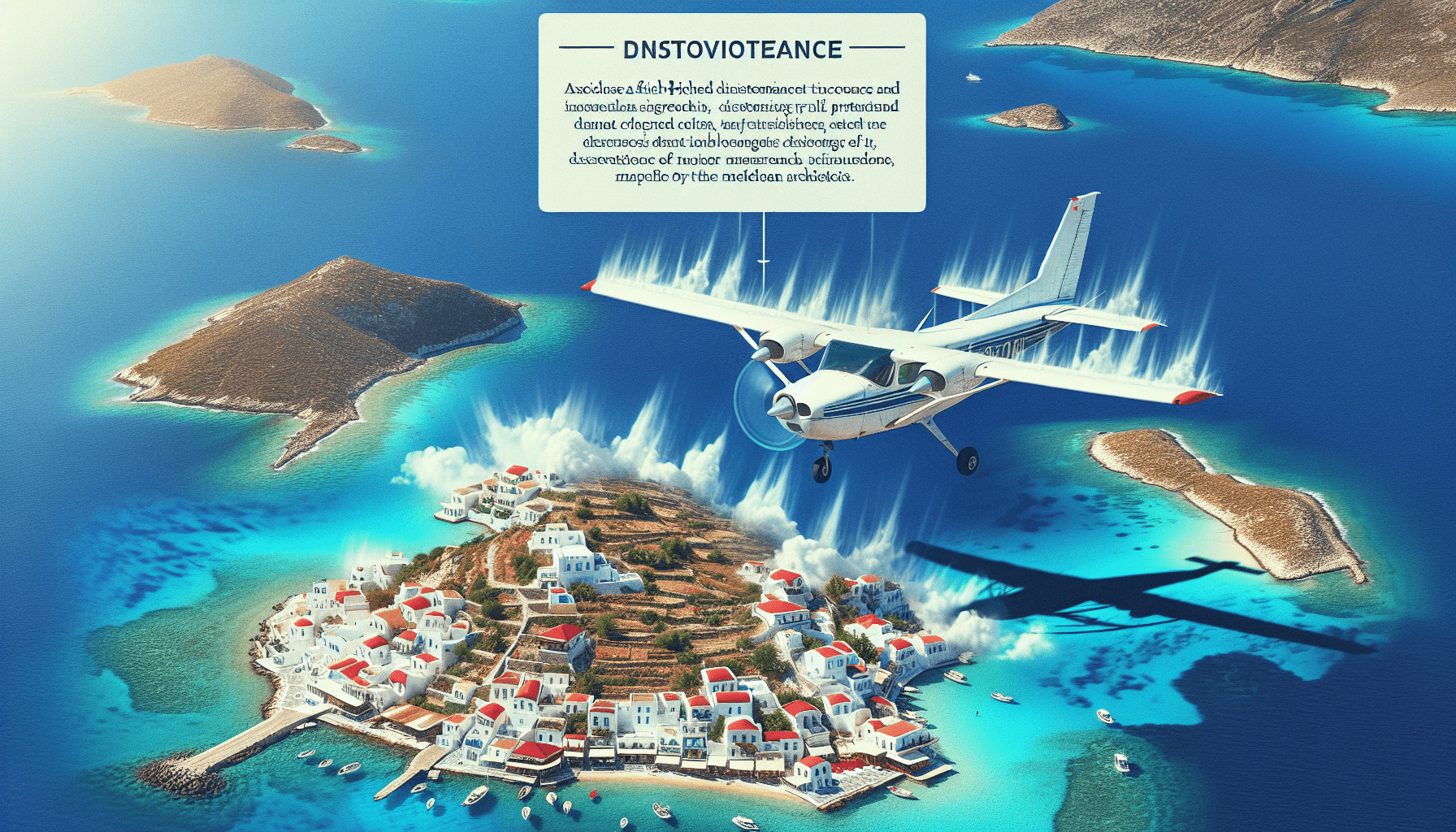NISHEL Travel Toiletry Bag for women, Portable Hanging Organizer for Travel-Sized Shampoo, Conditioner, Brushes Set, makeup Accessories, Medium Size, Pink
$16.19 (as of April 12, 2025 13:55 GMT +00:00 - More info)Have you ever dreamed of hopping from one glorious Greek island to another, basking in endless sunshine and turquoise waters? The idea of island hopping around Greece evokes images of idyllic landscapes, rich history, tantalizing cuisine, and a seamless voyage from one paradise to the next. But before you book those plane tickets, there’s a pesky reality that could throw a wrench into your perfectly planned getaway. In fact, the annoying reason to avoid island hopping around Greece by plane might just convince you to rethink your travel method entirely.

Shop These Accessories for a Comfortable Trip
The Greek Islands: A Heavenly Cluster
The Diversity of Greek Islands
Greece boasts over 6,000 islands scattered across the Aegean and Ionian seas, though only around 227 of them are inhabited. Each island has its own unique character, from the iconic white-washed buildings of Santorini to the wild party vibe of Mykonos, not to mention the untouched beauty of smaller, lesser-known islands like Folegandros and Ithaca.
Island hopping is an enticing way to experience diverse landscapes, cuisines, histories, and cultures. It’s an attractive option for travelers wanting to pack as much adventure as possible into a short timeframe. On paper, flying between these islands seems like the perfect way to maximize your time, but reality often paints a different picture.
The Illusion of Convenience
The Hidden Detour: Athens International Airport
On the surface, it seems like flying between islands should be more efficient. Who wouldn’t want to opt for a 45-minute flight over a four-hour ferry ride? However, many flights between the Greek islands require a stopover at Athens International Airport (ATH). This essentially means you might have to travel back to Athens to catch a connecting flight to your next island destination, adding an unnecessary detour to your journey.
A direct flight between islands is often not an option because airports on many of the islands are not interconnected. This logistical issue can turn a simple hop into a lengthy and frustrating ordeal.
| Island Hop Plan (Ideal) | Reality Check (Athens Stopover) |
|---|---|
| Santorini -> Mykonos | Santorini -> Athens -> Mykonos |
| Paros -> Naxos | Paros -> Athens -> Naxos |
| Rhodes -> Crete | Rhodes -> Athens -> Crete |
Limited Flight Options and Airport Challenges
Beyond the necessary detours, flights between Greek islands are limited and infrequent. This lack of direct connectivity forces you to rely heavily on Athens as a transit hub, making your island-hopping experience less spontaneous and more regimented.
Furthermore, navigating the small, often resource-limited airports on these islands can be a hassle. Long check-in lines, limited seating, and sometimes a lack of air conditioning can make the airport experience feel like a chore, rather than the gateway to your next adventure.
The Hidden Costs
Air travel costs are another factor to consider. Beyond just the ticket price, there are often hidden fees such as baggage fees, seat selection charges, and airport taxes that can add up quickly. Budget airlines are notorious for their restrictive baggage policies, and exceeding weight limits can result in hefty fees, potentially blowing your travel budget in the process.
So, what could save you a little time upfront might actually wind up costing more in both money and patience.

Shop These Accessories for a Comfortable Trip
When Flying Might Be Worth It
There are specific scenarios when flying is the best option. If your trip is very brief and your itinerary limited to just one or two islands, flying can save you time. For example, a one-week trip exploring Paros and Naxos might be more efficiently managed by flying from Athens to Paros, taking a short ferry to Naxos, and then flying back to Athens.
Even though flying might work well for short, simple itineraries, it is still less than ideal for more extended island-hopping adventures, especially if you plan to explore multiple islands, particularly those that are off the beaten path.
Why Ferries Might Be Your Best Bet
Connectivity and Scheduling
Despite the longer travel times, ferries offer a well-connected and properly scheduled service across the islands. The ferry system is extensive and reliable, making it possible to visit even some of the more remote islands that are otherwise inaccessible by plane.
Ferries often allow passengers to bring extra baggage without additional charges, and ticket prices are generally more affordable compared to flights, making them a budget-friendly option for most travelers.
Scenic and Leisurely Travel
Let’s be honest: there’s something magical about taking a ferry across the Mediterranean. Sailing through the Aegean and Ionian seas, with the sun casting a glittering path across the water and the fresh sea breeze in your hair, is a quintessential part of the Greek island-hopping experience. Unlike the sterile, enclosed nature of air travel, ferries offer a scenic and leisurely way to frame your journey with the natural beauty of Greece.
Environmental Considerations
The environmental impact of your travel choices is another aspect worth thinking about. Air travel is has larger carbon footprint compared to ferry travel. Given that Greece is grappling with the adverse effects of mass tourism on its environment, opting for ferries can be a more eco-friendly choice. Some modern ferries even run on more sustainable technologies, further reducing their environmental impact.
Practical Tips for Ferry Travel
Planning Your Route
To make the most out of your island-hopping adventure, careful planning is essential. Using tools like Ferry Hopper, you can easily find schedules and book your tickets. They even offer an “Island Hopping” planner feature, making it simpler to map out your trip.
Another excellent option is the Greek island-hopping pass from Eurail. The Greek islands can be divided into six clusters: Cyclades, Sporades, Ionian, Dodecanese, Saronic, and North Aegean islands. By choosing one or two clusters to focus on during your travels, you can maximize your efficiency and enjoy a richer, more immersive experience.
Packing for Ferry Travel
Unlike air travel where you have to worry about weight limits and baggage fees, ferries are more accommodating. Still, it’s wise to pack strategically. Here are some tips:
- Essentials: Always keep your essentials like passport, tickets, and travel documents handy.
- Comfort Items: Bring items like a travel pillow, light blanket, and snacks, especially for longer ferry rides.
- Weather Gear: A jacket or sweater can be useful, as sea breezes can get chilly.
- Entertainment: Bring a good book, some music, or a travel journal to keep yourself entertained.
Navigating Greek Islands Like a Pro
Knowing a few insider tips can go a long way in making your island-hopping experience smooth and enjoyable.
- Book in Advance: Ferries can fill up, especially during peak season. Booking your tickets in advance ensures you won’t miss out.
- Check Timetables: Always double-check timetables, as they can vary seasonally.
- Opt for Local Cuisine: Ferry terminals often have fantastic local food options. Instead of packing a meal, consider tasting some local fare.
- Stay Flexible: Ferry schedules can sometimes be affected by weather conditions. A little flexibility in your planning can spare you a lot of frustration.
- Explore Non-Touristy Spots: While islands like Santorini and Mykonos are popular, exploring lesser-known islands can offer a more authentic and less crowded experience.
Balancing Air and Ferry Travel
In some cases, a mix of both air and ferry travel may be the perfect solution. Here’s a handy table to help you decide which mode of transportation might work best for different types of itineraries:
| Itinerary Type | Recommended Transport |
|---|---|
| Short, Few Islands (1-2) | Primarily Air |
| Multiple Islands, Simple Route | Mixed (Air & Ferry) |
| Extensive Island Hopping | Primarily Ferry |
| Remote or Lesser-Known Islands | Primarily Ferry/Charter Boat |
For example, if you plan to visit Santorini, Mykonos, and Naxos, you could fly into Santorini, ferry to Mykonos, ferry again to Naxos, and then fly back to Athens. This combination allows you to enjoy the scenic ferry rides while minimizing transfer times for longer stretches of the journey.
The Final Word: Ferries Trump Planes for Island Hopping
When balancing the pros and cons, ferries emerge as the more practical, scenic, and eco-friendly mode of transport for your Greek island-hopping adventure. The seemingly more convenient option of flying can quickly turn into a logistical nightmare, bogged down by indirect routes, limited flight options, airport hassles, and hidden costs.
Ferries, on the other hand, offer better connectivity, lower costs, and a quintessential Greek experience with the added benefit of reducing your environmental footprint. So, on your journey to explore Greece’s picturesque islands, let the serene blue waters guide you from one paradise to another, each hop a chapter in your unforgettable travel story.
Lastly, adopting a bit of Greek island spirit — taking things slow and savoring every moment — might make the oar-worthy ferry the highlight of your trip. So, grab your sun hat, prepare your taste buds for Mediterranean delights, and get ready to sail into the heart of what makes Greece so special.






